Physical Address
304 North Cardinal St.
Dorchester Center, MA 02124
Physical Address
304 North Cardinal St.
Dorchester Center, MA 02124

Master minimalist bathroom design with 14 expert principles. Learn to incorporate floating vanities, seamless stone, and concealed storage for a true spa sanctuary.
“True luxury whispers; it never shouts.” I learned this lesson early in my career while designing a thermal suite for a resort in the Swiss Alps. We spent weeks debating the texture of a single limestone wall, acutely aware that the difference between a sterile clinic and a restorative sanctuary lies entirely in sensory details. A bathroom should not merely function; it must embrace you. Yet, residential design often confuses “minimal” with “cold,” leaving homeowners with high-gloss surfaces and harsh lighting that shock the senses rather than soothe them—a crucial mistake in minimalist bathroom design.
To achieve a genuine spa atmosphere, one must look beyond expensive fixtures and focus on emotional warmth. We often see renovations that prioritize clinical cleanliness, resulting in spaces that echo and glare. Real sophistication requires a strategic shift. It demands replacing reflective, sterile finishes with tactile, matte materials like Venetian plaster or thermally treated wood. Furthermore, it requires abandoning the single overhead light for layered, low-luminosity options that create soft, shadow-based definition.
We have analyzed the design decisions behind the world’s most exclusive wellness retreats to bring this balance to your home. From mastering the “invisible storage mandate”—ensuring every bottle and bin vanishes—to engineering acoustic softness, these principles transform a room’s character. The goal is to curate a space that offers profound calm and lasting value. Here is how to turn your bathroom into a genuine escape.
True luxury demands the confidence to leave space empty. In designing five-star hotel suites, I discovered that genuine opulence relies on “breathing room,” not excess. Treat negative space as your most exclusive architectural element. To capture this sophisticated calm, you must intentionally manipulate visual boundaries.

By removing visual competition, the bathroom shifts from a utility station to a personal sanctuary, allowing the quality of your materials to speak.
Luxury lies in the hand, not just the eye. While a monochromatic palette evokes calm, it risks feeling like a sterile clinic without tactile diversity. To elevate a white or grey bathroom, strictly apply the “Three Finish Rule.” Mix honed stone flooring, matte wall tiles, and high-gloss ceramic fixtures within the same color family. This trio creates dynamic contrast, forcing light to dance across surfaces rather than flattening them.
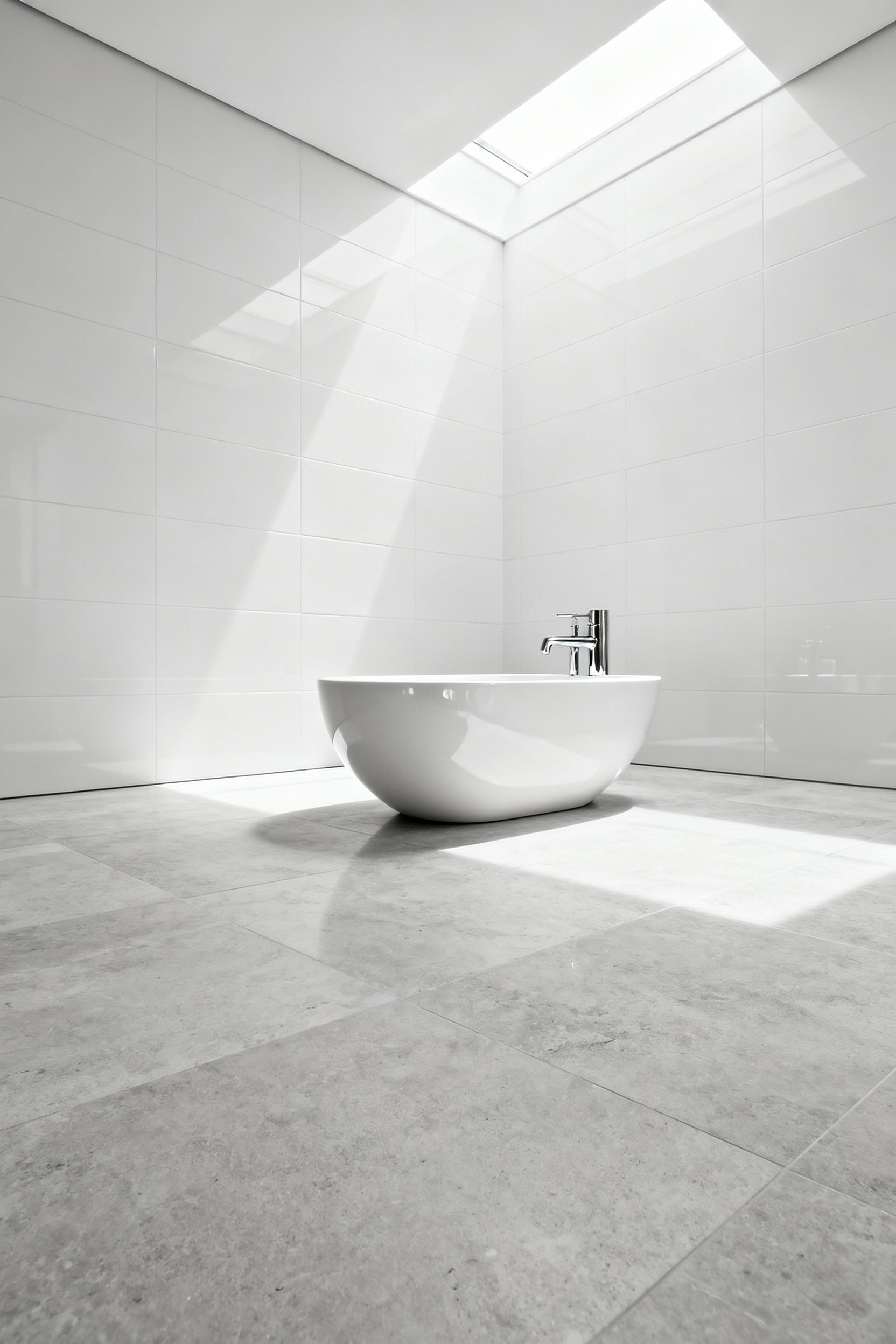
Anchor these cool tones with organic warmth to achieve an inviting, spa-like atmosphere.
These thoughtful layers transform a simple washroom into a sophisticated sensory experience.
High-end minimalism defines luxury by what is absent: visual noise. Standard tiles break the eye’s path with gridlines, but large-format porcelain slabs create a serene, unbroken flow. By utilizing panels as large as 120 inches, you virtually eliminate grout, mimicking the grandeur of natural stone without the porosity or maintenance headaches.
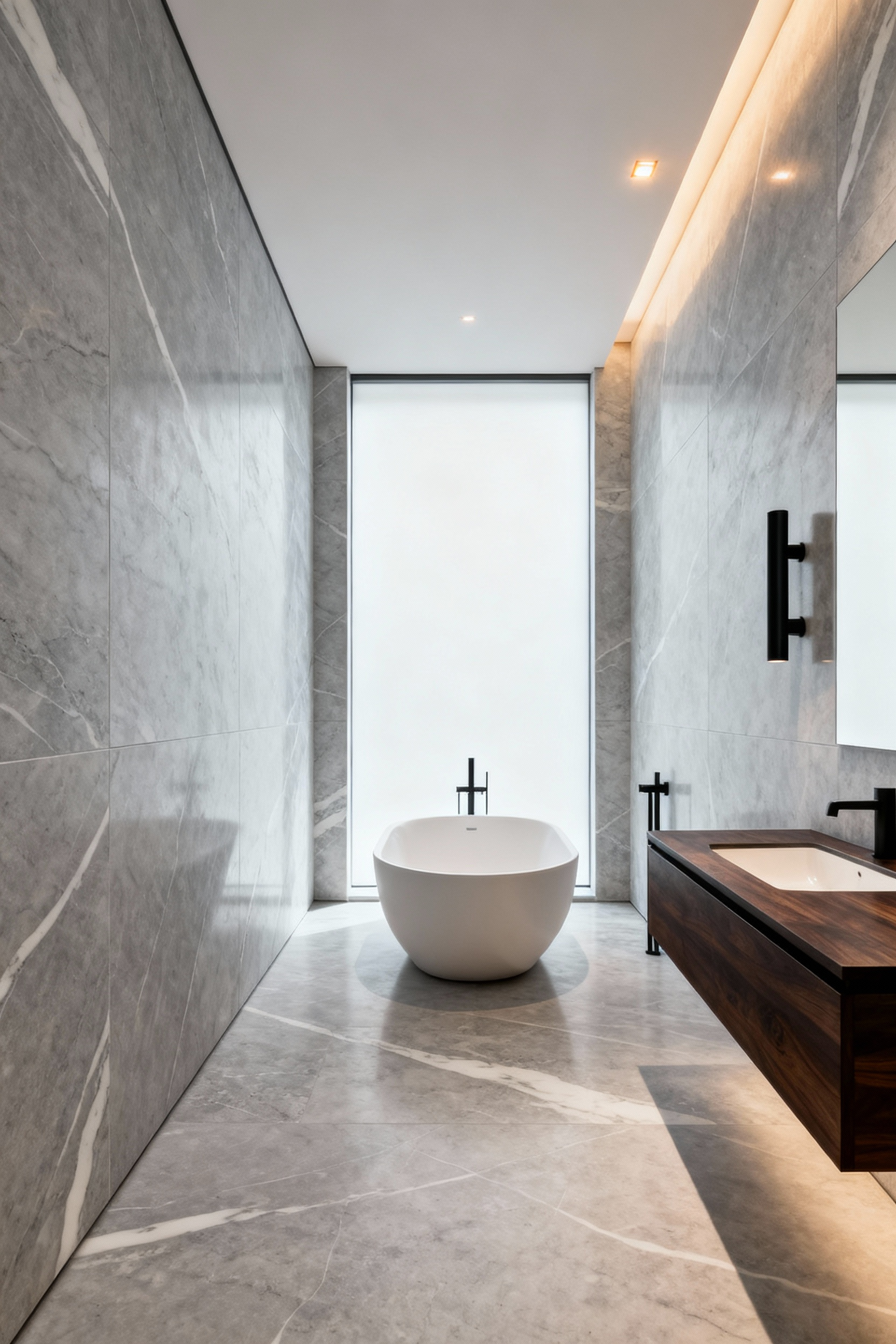
To truly replicate the sophistication of a luxury spa, treat the installation with architectural precision.
This approach transforms separate fixtures into a cohesive statement, making the entire room appear carved from a single block of stone.
In the world of high-end hospitality, visible floor space equals luxury. A wall-mounted vanity instantly creates the illusion of a grander room by revealing the flooring from wall to wall—an architectural sleight of hand used in boutique hotel suites to maximize spatial perception. This design choice transforms a heavy fixture into a sleek, hovering sculpture, eliminating the visual clutter of legs or kick plates. To master this monolithic look, prioritize handle-less cabinetry with push-to-open drawers, allowing storage to disappear into the architecture rather than protruding into your sanctuary.

Wall-mounting also offers a unique opportunity to customize ergonomics. Since the unit anchors directly to the studs, you can dictate the height—typically 34 to 36 inches—to suit your specific needs rather than settling for standard builder dimensions. To capture that five-star ambiance, apply these finishing touches:
Serenity starts where visual noise ends. Achieve this calm by treating your wall cavities as valuable real estate. Install fully recessed medicine cabinets that sit flush with the wall, creating a single, unbroken reflective plane. Banish protruding hardware that catches the eye and ruins clean lines; instead, specify push-to-open servo-drive technology for vanity drawers to keep surfaces sleek and uninterrupted.
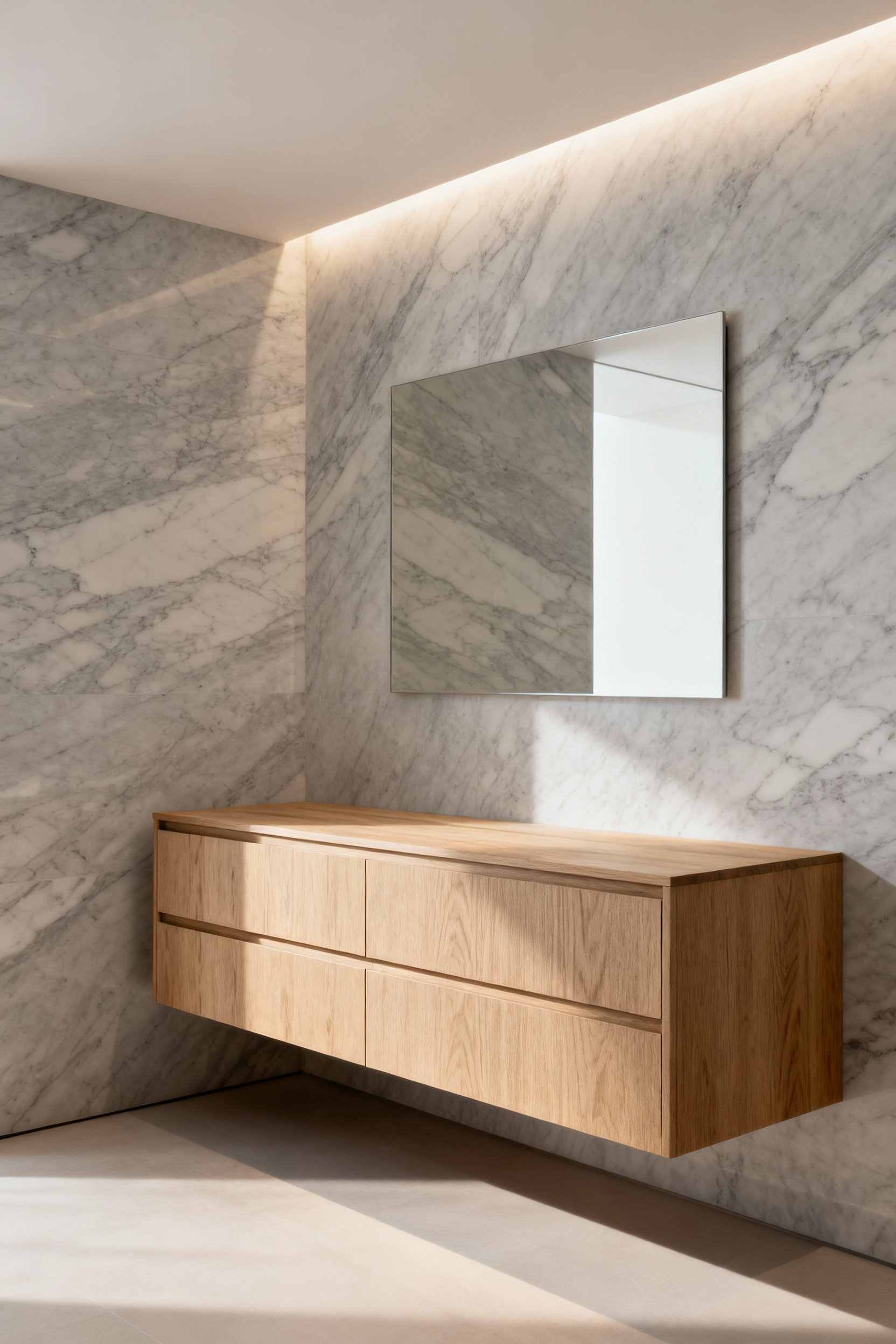
Extend this invisibility to the wet zone and utility areas. A sophisticated bathroom anticipates your needs without displaying your maintenance tools. To master the art of the “invisible housekeeping” effect:
This approach ensures your sanctuary remains pristine, regardless of what lies behind the panels.
The bathtub acts as a piece of living art, not a mere utility. Treat your freestanding tub as a sculptural focal point. Select monolithic materials like stone resin or solid surface composites for a seamless, matte finish. These materials eliminate visual clutter and feel undeniably expensive to the touch. To capture the hotel suite aesthetic, prioritize shape and placement:
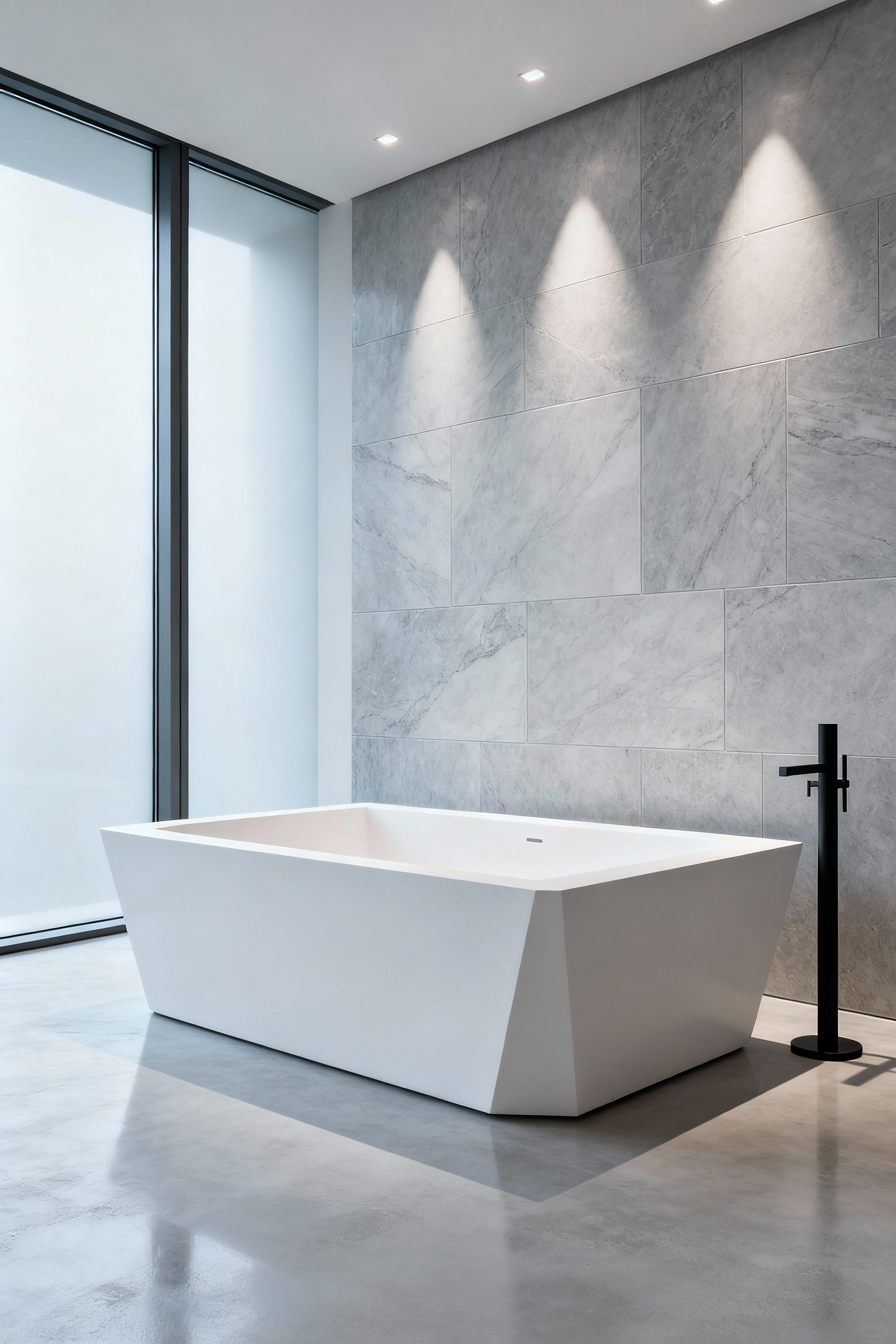
The hardware dictates the final polish. Pair your statement piece exclusively with a floor-mounted tub filler in matte black or brushed nickel. This keeps the walls unbroken and maintains a clean, sophisticated plane, anchoring the entire room in architectural luxury.
The most luxurious boundaries are the ones you cannot see. To achieve seamless flow, forego standard headers and heavy frames. Instead, specify floor-to-ceiling glass panels with recessed U-channels. By embedding these channels directly into the tile work, you eliminate visible tracks, creating the illusion that the glass rises organically from the floor. This technique expands visual volume, instantly transforming a standard bathroom into an airy, open-concept sanctuary.
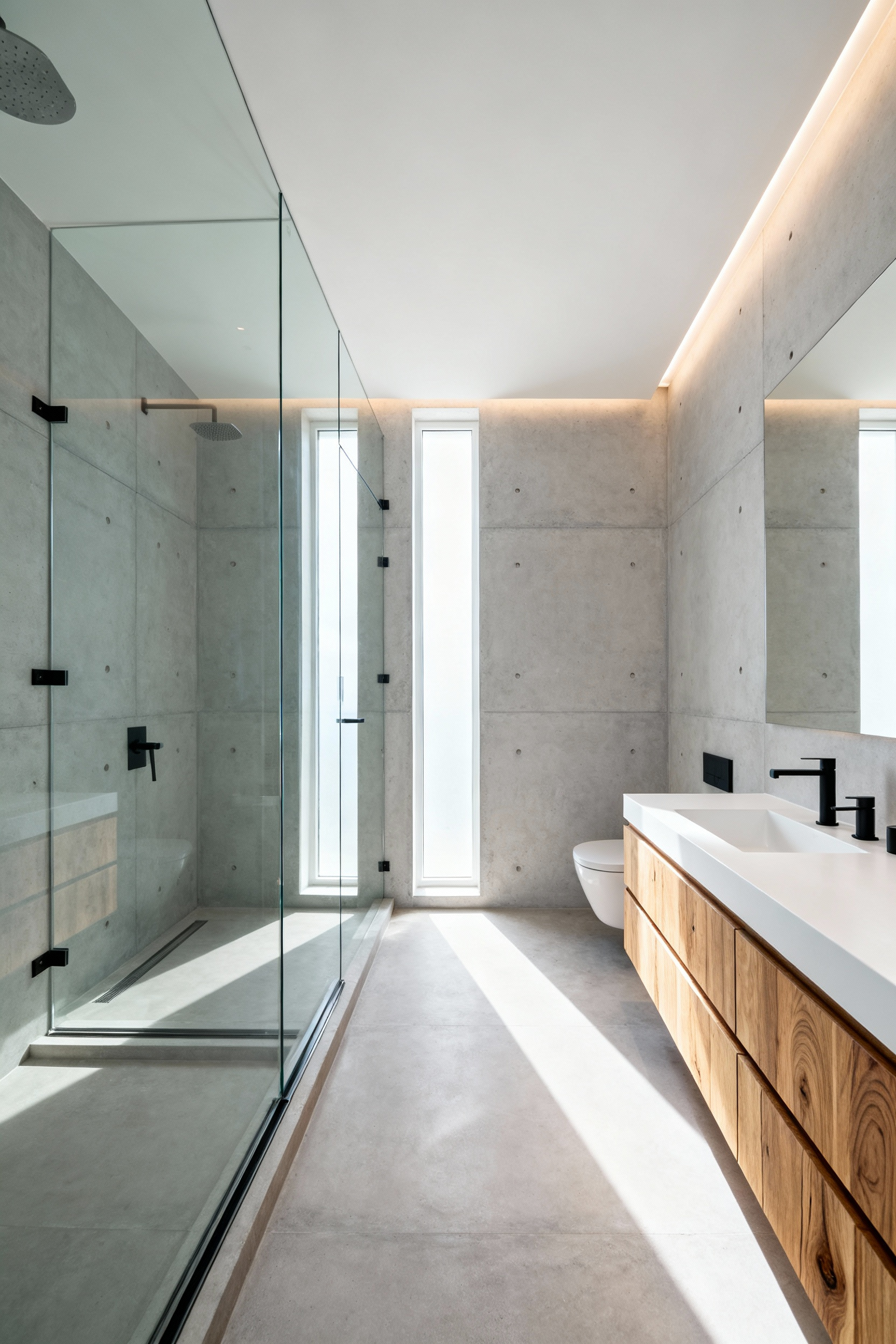
Clarity is non-negotiable. Standard glass often casts a green tint that disrupts a refined palette, so invest in 10mm low-iron glass for absolute transparency. Pair this with minimal, matte black or brushed steel pivots to maintain visual silence. Finally, protect your investment with a permanent hydrophobic coating. This essential treatment repels water and soap scum, ensuring your “invisible” wall remains truly invisible without the need for heavy scrubbing.
True luxury hides its mechanisms. Visible fixtures often create unnecessary visual noise; instead, integrate illumination directly into the architecture to wash surfaces with light rather than blasting the room from a single central bulb. Start by recessing high-CRI linear LED strips into your mirror casing or beneath a floating vanity. This provides accurate, shadow-free grooming illumination while keeping your sightlines unbroken and clean.

To elevate the space from a functional bathroom to a private sanctuary, you must manipulate depth and temperature. A flatly lit room feels sterile; therefore, use small-aperture “pinhole” spotlights to graze textured stone walls or highlight shower niches. Adopt the hospitality industry’s secret for versatile atmosphere: Tunable White technology. This allows you to distinctively shift the room’s energy:
Treat hardware as the refined jewelry of your bathroom. These fixtures anchor the visual narrative, ensuring every touchpoint feels substantial and deliberate. Commit to the “Rule of Unification”: select one dominant finish and apply it universally across faucets, shower systems, and cabinet pulls. This discipline creates the intentional coherence found in five-star suites.
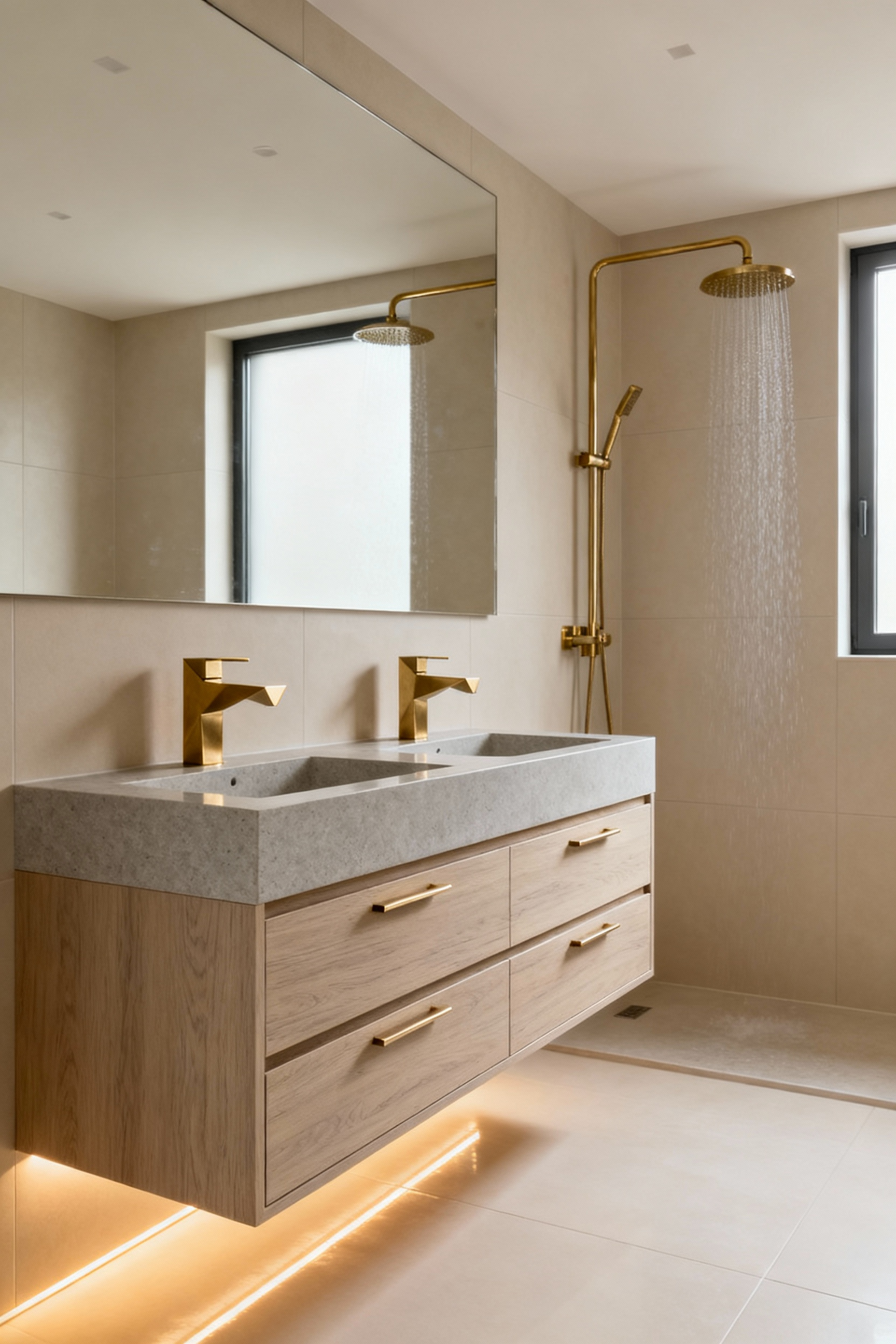
The finish dictates the mood. Choose Matte Black to sharply define geometric lines and ground airy, neutral palettes. Conversely, utilize Brushed Gold to introduce sophisticated warmth, preventing cool marble or concrete from feeling sterile. Regardless of the hue, prioritize pure form over ornamentation:
Luxury lies in restraint; allow the material to speak for itself without the distraction of complex shapes.
Luxury thrives on balance, not starkness. Marble and concrete alone can often feel clinical, so you must inject organic warmth to create a welcoming sanctuary. Anchor your minimalist bathroom with a floating vanity crafted from light oak or teak. These moisture-resistant woods endure humidity, while the suspended design preserves valuable floor space. The resulting contrast between soft grain and sleek tile instantly elevates the room from sterile to sophisticated.

Practical durability remains paramount in wet zones. For shower floors or walls, opt for high-end porcelain tiles that mimic the texture of wood grain. This hospitality trade secret delivers the aesthetic of timber without the water damage risk. Finally, layer in warmth through flexible accessories:
By focusing on these tactile details, you soften modern lines and achieve the refined comfort found in world-class spas.
Technology should serve you, not clutter your view. In the best modern design, the most impressive feature is invisibility; we create spaces where comfort simply appears without visual noise. To replicate this sophistication, prioritize systems that vanish completely when idle. For instance, select high-end smart mirrors that use semi-transparent glass to conceal LED displays until you actively engage them.

You must aggressively eliminate the chaos of cords and controls. Implement these invisible solutions to maintain clean, architectural lines:
Consequently, your bathroom remains a serene sanctuary rather than a tech showroom. By hiding the hardware, you allow the quality of your materials—the marble, wood, and glass—to take center stage.
True biophilic design involves more than simply placing a plant on a counter; it requires curating a cohesive sensory experience. Avoid cluttering your pristine surfaces with clusters of small pots. Instead, anchor the room with a single architectural botanical, such as a tall Snake Plant in a matte concrete vessel, to introduce life without visual chaos. Offset the clinical coolness of minimalist fixtures with raw, tactile warmth—a reclaimed wood vanity or a river-stone floor mat instantly grounds the space, bridging the gap between modern efficiency and organic comfort.

To fully capture that seamless ‘resort garden’ atmosphere, manipulate the room’s boundaries and ambiance. Use large-format natural stone tiles that flow continuously into the shower area to dissolve rigid lines and mimic an open-air terrace. Finally, elevate the mood by engaging the remaining senses:
In luxury design, essentials should never float aimlessly on a countertop. Anchor your vanity with a statement tray to create a focal point. Choose a material that provides a tactile contrast, such as matte black slate against white quartz or honed marble on wood. This foundation instantly transforms scattered toiletries into a deliberate vignette of *controlled luxury*, proving that organization is the ultimate sophistication.

Curate the contents with ruthless precision. Eliminate brand noise by decanting commercial products into uniform, refillable vessels like amber glass or ceramic pumps. Furthermore, adhere to the hospitality industry’s “Rule of Three” to ensure the arrangement feels balanced rather than cluttered:
By displaying only what is immediately necessary, you elevate a daily routine into a sophisticated ritual.
Textiles act as structural elements, not mere accessories. Minimalist bathrooms often rely on cold materials like concrete and glass, so they demand a tactile counterpoint. Invest in 700+ GSM Turkish or Egyptian cotton towels in pure white or soft gray. This specific density absorbs sound and softens harsh lighting, effectively curing the sterility often associated with stripped-back design.
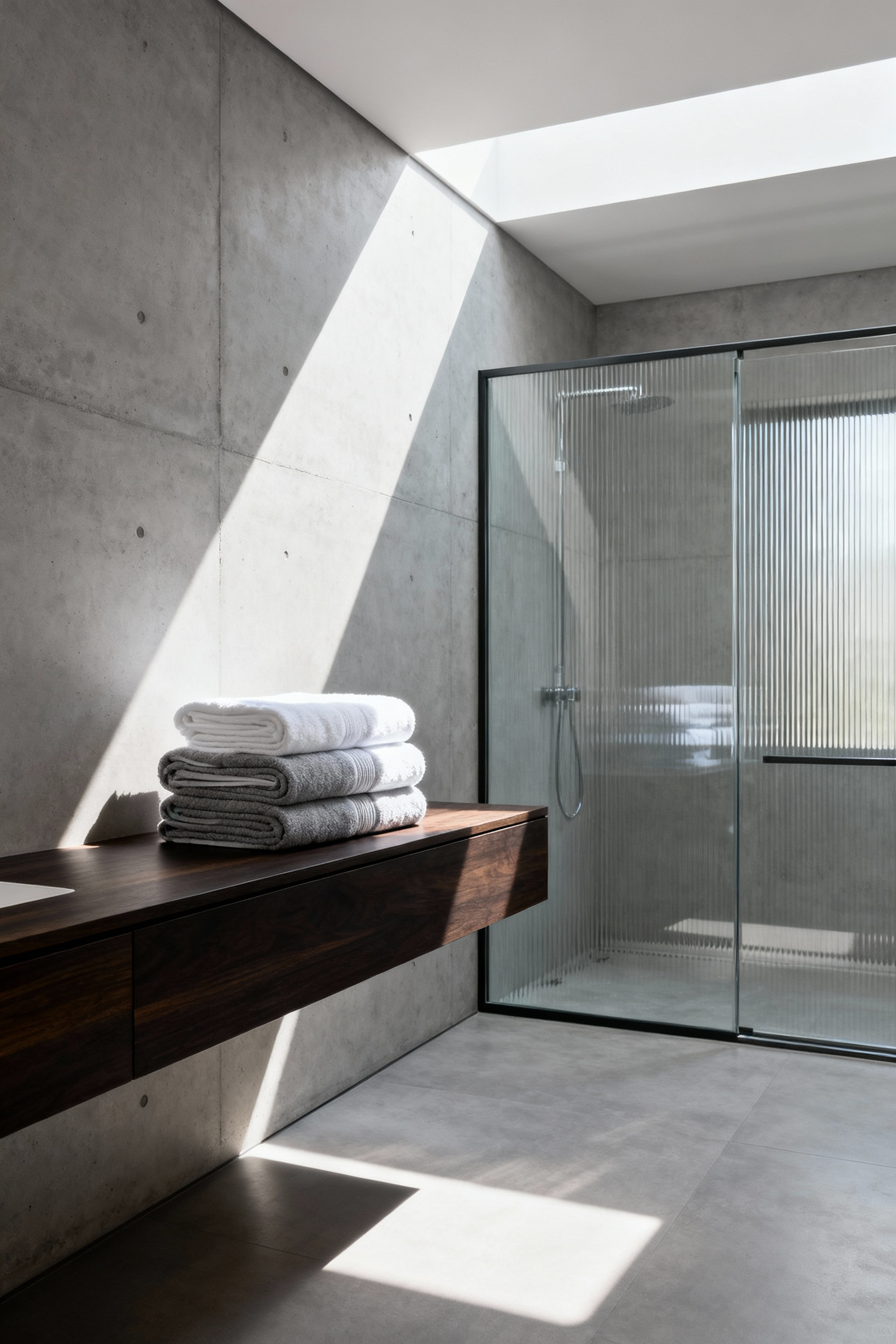
Embrace strategic scarcity. Luxury whispers through restraint, so avoid cluttering rails with excess fabric. Instead, curate a deliberate “display set” to elevate the room:
This discipline transforms functional necessities into a sophisticated, sensory experience.
True minimalism extends far beyond the mere absence of clutter; it curates a sophisticated sanctuary for the senses. As practiced in the world’s finest hotels, the secret lies in intentional subtraction. By prioritizing concealed integration and a restrained, tonal palette, you eliminate visual noise to let the architecture breathe. This shift allows the focus to move from what is missing to the elevated quality of what remains, transforming a utilitarian space into a dedicated pause in your day.
To achieve this level of timeless appeal, invest deeply in the tactile and the atmospheric. Select materials like honed stone or warm teak that invite touch, and strictly avoid clinical, singular light sources. Instead, layer your lighting to manipulate mood and soften the room’s edges. When functionality disappears behind seamless design, the experience takes center stage, proving that luxury is defined by how a space makes you feel, not just how it looks.
Ultimately, creating a personal retreat requires looking past fleeting trends to embrace these enduring principles of minimalist bathroom design. Commit to hidden functionality and sensory depth. Start by evaluating your surfaces today, then plan for the permanent upgrades that bring hospitality-level serenity home. You deserve a space that restores you, not just one that serves you.